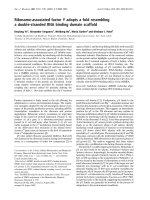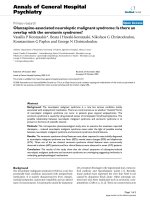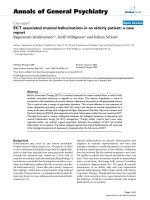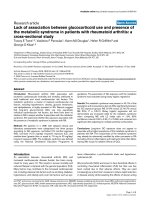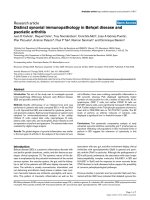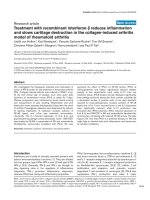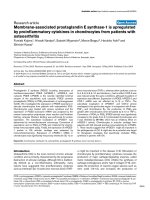Báo cáo y học: "Virally associated arthritis 2008: clinical, epidemiologic, and pathophysiologic considerations" doc
Bạn đang xem bản rút gọn của tài liệu. Xem và tải ngay bản đầy đủ của tài liệu tại đây (71.9 KB, 8 trang )
Page 1 of 8
(page number not for citation purposes)
Available online />Abstract
Several viruses have been associated with the development of
inflammatory arthritis, including the hepatitis viruses (hepatitis B
virus and hepatitis C virus), HIV, the parvovirus B19, the human
T-cell lymphotropic virus-I, and the alphaviruses. Here, we review
the epidemiology, the pathophysiological mechanisms, the
pertinent clinical and laboratory findings as well as the principles of
therapy of the most common virus-associated arthritides. We
believe that the knowledge of these key diagnostic and therapeutic
features of virus-associated arthritides is important for the rheuma-
tologist of the 21st century.
Introduction
The spectrum of human viral infections is vast. Considering
their ubiquity, clinically significant rheumatic manifestations,
including arthritis, are relatively rare. Despite this generality,
viral infections can and do cause a number of clinically impor-
tant arthritic syndromes. Some are acute, mimicking early-
onset rheumatoid arthritis (RA) such as seen in parvovirus
B19 and hepatitis B virus (HBV) infection and others.
Alternatively, some viral infections are associated with more
chronic forms of arthritis, which can be challenging both
diagnostically as well as therapeutically. Other infections are
important from a public health perspective and the rheuma-
tologist may have the opportunity to make an early diagnosis
of a serious or epidemic condition. It is beyond the scope of
this review to describe all viral infections with reported arthritic
complications. The goal is to highlight those infections that are
most relevant to the rheumatology practitioner by providing
pertinent information on the pathogen, its epidemiology,
presumed pathogenic mechanisms, most common clinical
features of articular disease, and principles of therapy.
Classification of viral infections and the
pathogenesis of virally associated arthritis
Viral infections can be classified based on a number of
microbiologic and molecular features and are organized most
broadly as to whether their genomes contain DNA or RNA
and whether they encode and replicate through reverse
transcriptase. The International Committee on Taxonomy of
Viruses has recognized 5,450 viruses as specific species
based on molecular structure and organized into families [1].
A more practical approach of classification is to consider the
pathogen based on its clinical pattern of infection [2]. Acute
viral infections are those with a finite beginning and end in
which it appears that the host is capable of overcoming the
assault by ridding itself of the invader. Such is the pattern of
many common infections, including rhinovirus and influenza,
in which there appears to be no significant incidence of viral
latency or chronicity. A second and extremely common
pattern is that of viral latency. In this model, there may be a
clinically apparent or subclinical primary infection followed by
a prolonged and often lifelong period of latency with possible
periods of clinical or subclinical relapses. Herpes virus infec-
tions are classically associated with latency. As examples,
varicella zoster virus reactivation is generally associated with
a dramatic clinical event (that is, dermatomal zoster) whereas
Epstein-Barr virus (EBV) infection is more often associated
with recurrent bouts of asymptomatic viral shedding. At the
molecular level, latency is even more complex and the inter-
mediate expression of viral components under the influence
of both viral and host factors is an area of intense interest and
research. Finally, there are relatively few viral pathogens that
are associated with chronic replicative persistence. In this
Review
Virally associated arthritis 2008: clinical, epidemiologic, and
pathophysiologic considerations
Dimitrios Vassilopoulos
1
and Leonard H Calabrese
2
1
Athens University School of Medicine, 2nd Department of Medicine, Hippokration General Hospital, 114 Vass., Sophias Avenue, 115 27 Athens,
Greece
2
Cleveland Clinic, Lerner College of Medicine of Case Western Reserve University, Department of Rheumatic and Immunologic Diseases, The
Cleveland Clinic Foundation, 9500 Euclid Avenue, Desk A50, Cleveland, OH 44195, USA
Corresponding author: Leonard H Calabrese,
Published: 18 September 2008 Arthritis Research & Therapy 2008, 10:215 (doi:10.1186/ar2480)
This article is online at />© 2008 BioMed Central Ltd
ALT = alanine aminotransferase; ANA = antinuclear antibody; anti-CCP = anti-cyclic citrullinated peptide; anti-TNF = anti-tumor necrosis factor;
AST = aspartate aminotransferase; CHIKV = Chikungunya virus; DMARD = disease-modifying antirheumatic drug; EBV = Epstein-Barr virus;
HAART = highly active antiretroviral therapy; HBV = hepatitis B virus; HCV = hepatitis C virus; HTLV-I = human T-cell lymphotropic virus type I; IFN-
α = interferon-alpha; IVIG = intravenous immunoglobulin; NSAID = nonsteroidal anti-inflammatory drug; PAN = polyarteritis nodosa; PCR = poly-
merase chain reaction; RA = rheumatoid arthritis; RF = rheumatoid factor; SLE = systemic lupus erythematosus.
Page 2 of 8
(page number not for citation purposes)
Arthritis Research & Therapy Vol 10 No 5 Vassilopoulos and Calabrese
model, acute infection may be clinical or subclinical followed
by a prolonged and commonly lifelong period of continuous
viral replication as seen in all cases of HIV infection, most
cases of hepatitis C virus (HCV) infection, and less commonly
in adult-acquired HBV infection. Some caution should be
exerted in the acceptance of this simplified classification
scheme as the concepts of acute, latent, and persistent
infections may be oversimplistic. For example, parvovirus B19
represents an infection that – in hosts with normal immune
systems – is clinically acute, but the persistence of apparently
nonreplicating virus can frequently be demonstrated with
molecular techniques in the bone marrow of patients with
arthritis and in healthy controls [3]. Despite such limitations of
classification by clinical pattern, the approach remains
clinically useful.
While our knowledge of the pathogenesis of virally associa-
ted arthritis has gaping holes, the disease is believed to
develop as the result of several non-mutually exclusive
mechanisms, including direct viral infection and the induction
or amplification of autoimmunity by the virus. In either case,
immune factors are central. When a pathogen invades a joint,
it may induce an inflammatory reaction via lytic effects on host
tissues, immune complex formation, or the induction of
inflammatory cytokines such as the well-documented effects
of certain alphaviruses that target mononuclear cells within
the joint [4]. Alternatively, viruses can induce autoimmunity
and inflammation via numerous mechanisms such as
molecular mimicry, bystander activation, or epitope spreading
[5]. In most cases of virally associated arthritis, however, the
mechanisms are poorly understood.
Hepatitis B virus
Despite widespread vaccination programs, chronic HBV
infection remains one of the most common chronic viral infec-
tions, with approximately 350 million people infected world-
wide [6]. HBV is an enveloped double-stranded DNA virus
transmitted parenterally, sexually, or vertically. In the majority
of cases during adulthood (>95%), exposure to the virus is
followed by a successful host immune response demon-
strated by activation of both cellular and humoral immune
mechanisms leading to liver inflammation (acute hepatitis)
and eventually viral clearance.
Arthritis in patients with HBV can be encountered in two
settings: as an RA-like, acute, self-limited polyarthritis during
the presymptomatic phase of acute hepatitis B or more rarely
as arthritis occurring in the context of HBV-associated
polyarteritis nodosa (PAN). In both cases, the pathogenesis
of the arthritis is attributed to the deposition of immune
complexes containing viral antigens (HBV surface antigen
HBsAg or HBeAg) and their respective antibodies (anti-HBs
and anti-HBe) in synovial tissues. A direct role for HBV in
tissue inflammation has also been proposed, based on the
detection of active HBV replication in endothelial cells from
diseased tissues in HBV-associated PAN [7]. Whether a
similar mechanism is involved in HBV-related arthritis remains
to be confirmed.
In a small proportion of patients, during the preicteric phase
of acute hepatitis B, a symmetric polyarthritis can develop [8].
The polyarthritis has the typical characteristics of RA with
common involvement of the proximal interphalangeal joints,
knees, and ankles [8]. Clues to a possible diagnosis of HBV-
associated arthritis are the presence of rash (maculopapular,
urticarial, or rarely petechial) accompanied by fever, malaise,
and myalgias. Rheumatoid factor (RF) can be positive in
about one fourth of patients whereas C3 and C4 are found to
be low in approximately 40% of patients, indicative of an
immune-complex-mediated process. The detection of positive
HBsAg, highly elevated aminotransferases (aspartate
aminotransferase [AST] and alanine aminotransferase [ALT]),
and IgM anti-HBc antibodies provides the definite diagnosis
of HBV-associated polyarthritis. No treatment is required
since the arthritis resolves spontaneously after 2 to 3 weeks.
HBV-associated PAN is decreasing in frequency worldwide
[9]. In most cases, PAN develops during the first 6 months of
HBV infection and its clinical presentation and course do not
differ significantly from those of classical PAN [9]. Arthralgias
are common, occurring in approximately 50% of patients, and
are usually accompanied by myalgias. Frank arthritis, affecting
predominantly large joints (knees, ankles, and wrists), is
observed in only a small proportion of patients [9]. The
management of HBV-associated PAN includes immunosup-
pressives (corticosteroids, cyclophosphamide in severe
cases) and antiviral therapy (nucleoside or nucleotide
analogs). For patients who achieve initial remission, the
overall prognosis is good, with less than 10% of patients
relapsing [9].
Hepatitis C virus
Chronic HCV infection is a worldwide public health problem,
with more than 170 million people affected [10]. HCV is an
RNA hepatotropic virus that is transmitted parenterally, mainly
through injection drug use. Patients who had been transfused
with blood or blood-derived products prior to 1992 and
persons with multiple sexual partners are also at increased
risk [11]. In contrast to HBV, the majority of adult patients
(55% to 85%) exposed to HCV develop chronic infection
[10]. Depending on a number of factors such as older age,
alcohol abuse, and presence of liver steatosis and
coinfections (HIV), around 20% of patients develop end-
stage liver disease and 10% develop hepatocellular
carcinoma during the course of their chronic infection.
The appearance of articular symptoms in the form of either
arthralgias or frank arthritis in a patient with chronic HCV
infection often puzzles the caring physician. Joint manifes-
tations in patients with chronic HCV infection can be
encountered in four different forms: a coexistent arthropathy
(not related to HCV), arthritis in the setting of mixed
Page 3 of 8
(page number not for citation purposes)
cryoglobulinemia, arthritis directly related to HCV (HCV-
associated arthritis), and arthritis induced by antiviral therapy
(interferon-alpha [IFN-α]) [12]. A correct diagnosis in this
setting is not always easy to make and is obviously of
paramount importance for the design of the appropriate
therapeutic approach.
Probably the most common cause of arthritis in HCV patients
is the mere coexistence of another inflammatory (RA, sys-
temic lupus erythematosus [SLE], Sjögren syndrome, and so
on) or noninflammatory (fibromyalgia) rheumatic disorder,
which can be expected based on the prevalence of these
diseases in the particular population. Some of these
rheumatic disorders often share clinical manifestations and
laboratory findings with chronic HCV infection without
articular manifestations such as sialadenitis, generalized
fatigue, positive RF (40% to 65%), cytopenias, antinuclear
antibodies (ANAs) (10%), or low C4 levels. The presence of
certain laboratory (anti-cyclic citrullinated peptide [anti-CCP]
for RA, anti-double-stranded DNA for SLE, and anti-Ro/La for
Sjögren syndrome) or radiological (erosive changes in RA)
findings is helpful for the differential diagnosis.
The treatment of these coexistent rheumatic disorders should
always be made after careful evaluation of the status of the
underlying chronic liver disease (mild hepatitis, advanced
fibrosis, and compensated or decompensated cirrhosis) [13].
In cases in which long-term immunosuppression with medica-
tions with potential hepatotoxicity is planned (methotrexate
and leflunomide), a baseline liver biopsy and a consultation
with a hepatologist are appropriate. In patients with advanced
fibrosis in liver biopsy or with clinical evidence of decom-
pensated cirrhosis (ascites, encephalopathy, or coagulo-
pathy), these medications should be avoided [14]. In patients
with less advanced disease and stable liver function, these
medications can be used with close monitoring of liver
function. Recently, there have been a number of small open
studies demonstrating the short-term safety of anti-tumor
necrosis factor (anti-TNF) and anti-B cell (rituximab) agents in
rheumatic patients with chronic HCV infection [13]. For anti-
TNF agents (etanercept), especially, data from a small
randomized single-center study indicated its safety and
efficacy when given in combination with antiviral treatment in
patients with chronic hepatitis C [15]. The most recent
recommendations for the treatment of RA from the American
College of Rheumatology also suggested that anti-TNF
agents can be given in patients with chronic compensated
HCV infection [14]. Results from ongoing randomized trials
are expected to provide more definite data regarding the
safety of anti-TNF agents in patients with chronic hepatitis C.
The second scenario is an inflammatory arthritis occurring in
the setting of HCV-associated mixed cryoglobulinemia [16].
Cryoglobulins can be detected in approximately half of
chronically HCV-infected patients but less than 5% develop
the distinct manifestations of the mixed cryoglobulinemia
syndrome such as purpura, neuropathy, membranoproliferative
glomerulonephritis, and so on [16,17]. An immune-mediated
process through the deposition of monoclonal RF or immune
complexes containing RF and polyclonal IgG, with or without
associated HCV antigens, in small vessel walls in different
tissues such as the skin, nerves, synovium, and glomeruli is
the presumed pathogenetic mechanism [18]. In the majority
of cases, patients with mixed cryoglobulinemia present with
intermittent nonspecific polyarthralgias involving the hands
and knees whereas less than 10% develop frank nonerosive
arthritis. The diagnosis of arthritis in HCV-associated mixed
cryoglobulinemia requires the recognition of a combination of
clinical (purpura, membranoproliferative glomerulonephritis,
peripheral neuropathy, and skin ulcers), serologic (type II or III
cryoglobulins, low C4, and positive RF), and histological
(leucocytoclastic vasculitis) findings. The treatment of mild to
moderately severe HCV-associated mixed cryoglobulinemia
includes combination antiviral treatment (pegylated IFN-α +
ribavirin) with or without low-dose corticosteroids (pred-
nisone of less than 10 mg/day) [19]. In more severe cases,
high-dose corticosteroids, cyclophosphamide, rituximab, and/or
plasmapheresis followed by antiviral treatment have been
used [20].
In less than 5% of patients with chronic HCV infection, an
inflammatory arthritis directly related to HCV has been
reported [21]. The pathogenetic role of HCV in these cases
has not been proven. Most patients present with an RA-like
picture of a symmetric, nondeforming, nonerosive polyarthritis
involving predominantly small joints (metacarpo-phalangeals,
proximal interphalangeals, and ankles). In approximately 20%
of the cases, a mono- or oligo-arthritic pattern is observed. In
the reported cases in the literature, approximately 40% were
cryoglobulin-positive and 70% RF-positive, making the
differential diagnosis from early RA or HCV-associated mixed
cryoglobulinemia challenging [21]. The presence of anti-CCP
antibodies is helpful for the diagnosis of RA in this setting,
but it should be noted that approximately one third of patients
with early RA are anti-CCP-negative. There are limited data
on the treatment of HCV-associated arthritis; analgesics, low-
dose corticosteroids (<10 mg/day), and (rarely) disease-
modifying antirheumatic drugs (DMARDs) or anti-TNF agents
can be used [21]. Rarely, patients with chronic hepatitis C
receiving treatment with IFN-α can develop inflammatory
polyarthritis or true RA [12].
Parvovirus B19
Parvovirus B19 is a member of the family of small,
nonenveloped, single-stranded DNA viruses Parvoviridae and
is the cause of the common childhood illness erythema
infectiosum as well as of transient aplastic crisis, hydrops
fetalis, and bone marrow suppression in immunocompro-
mised patients [22]. The infection is spread by the respiratory
route and has a household transmission rate of approximately
50%. Nearly half of the adult population is IgG anti-B19-
positive. Of interest is the fact that, in children with erythema
Available online />infectiosum, articular disease is uncommon, with joint
swelling in less than 3% of those infected under 10 years of
age. In adults, however, where the infection commonly occurs
in the absence of the characteristic rash, arthralgia is far more
common [22]. Symptoms begin in a few joints but rapidly
spread, often in an additive fashion. The pattern of joint
involvement is RA-like and is accompanied by prominent
morning stiffness, thus posing a diagnostic challenge in
patients presenting with acute-onset polyarthritis. Further
confounding the diagnostic situation is the well-documented
occurrence of transient autoantibody formation including RF
(generally in low titer), ANAs, anti-DNAs, antibodies against
extractable nuclear antigens, and others. Clearly, the constel-
lation of cytopenias, polyarthritis, and ANA or anti-DNA can
mimic SLE as well. B19-associated arthritis is self-limited and
generally resolves in a few weeks but occasionally lasts much
longer. Chronic arthritis secondary to B19 infection has been
reported but its causal role in such cases is uncertain [2].
The pathogenesis of B19-associated arthritis is believed to
be driven by virus-specific antibody and immune complex
formation since articular symptoms seem to coincide with the
appearance of B19-specific IgM. Diagnosis is confirmed by
the presence of specific IgM antibodies with or without
specific IgG, while the detection of IgG alone is consistent
only with past infection. Virus can also be detected in serum
by polymerase chain reaction (PCR) at such times, although
this is not clinically necessary. The issue of major importance
in terms of diagnosis is not to confuse B19 infection with
early-onset RA [2]. B19 can be detected in the synovium of
patients with both RA and osteoarthritis and the significance
in these settings, while debated, is not believed to be etio-
pathogenic [23]. Treatment is generally supportive, although
intravenous immunoglobulin (IVIG) has been used success-
fully to treat chronic B19 infection to allow marrow recovery.
IVIG is not recommended in B19-associated arthritis [2].
HIV infection
The epidemic of HIV infection is now over a quarter century
old. While globally it is still pandemic, in the industrialized
West the disease has been transformed into a chronic,
complex, but largely manageable disease for those with
access to antiviral drugs and who tolerate multiple-drug
therapy commonly known as highly active antiretroviral
therapy (HAART). The early days of HIV disease predating
the use of HAART (1996 and before) were associated with
rich clinical descriptions of nosologically distinct forms of
arthritis that at times were clinically severe [24]. These
articular syndromes were heterogeneous and are listed in
Table 1. In the era of HAART, there has been a transformation
in the incidence of associated arthritis with several studies,
including the only longitudinal cohort investigation, clearly
documenting a significant and dramatic decrease in these
complications [25]. In their place are a number of heretofore-
undescribed rheumatic disorders; one example of a new
nosologic entity is the immune reconstitution syndrome seen
with the initiation of HAART in severely immunosuppressed
patients [26]. In this syndrome, patients with previously occult
opportunistic infections due to mycobacteria or other patho-
gens, when exposed to HAART, experience a resurgence of
their CD4 counts in the peripheral blood and tissues, accom-
panied by an inflammatory syndrome characterized by fever,
lymphadenopathy, and serious end-organ damage. The
syndrome is believed to result from the reconstitution of the
flagging immune system with a resultant inflammatory
reaction to previously occult and clinically asymptomatic
infection. While this immune reconstitution syndrome was
originally reported in reaction to occult infections, a sterile
form that is associated with the appearance of new-onset
autoimmune or inflammatory disorders, including arthritis, has
also been described [26]. The syndrome is generally self-
limited and thus clinically important in terms of not over-
treating it. Nonsuppurative rheumatic syndromes continue to
be prevalent in areas without access to HAART, including
most of Africa and large parts of Asia [25].
Alphaviruses
Inflammatory polyarthritis has long been associated with
alphavirus infections but for rheumatologists in the indus-
trialized West these disorders have been little more than
curiosities [27,28]. Among the 26 members of the genus, all
are arboviruses [4]. Aside from Ross River disease, which
infects approximately 9,000 individuals annually and has been
intensively investigated, the remaining infectious agents that
are all associated with arthritis (Table 2) are endemic to
tropical zones and have been less rigorously studied [29].
Over the past 2 years, there has been an epidemiologic shift
in at least one of these viruses, Chikungunya virus (CHIKV),
which is both clinically fascinating and of clinical importance
to global health. CHIKV, like other members of the genus, is a
single-stranded RNA virus and is a mosquito-borne infection
that in the past has been responsible for significant
epidemics in Asia and Africa [27]. In 2006, an outbreak of
CHIKV swept over several islands in the Indian Ocean and in
parts of India proper. During the same period, increasing
Arthritis Research & Therapy Vol 10 No 5 Vassilopoulos and Calabrese
Page 4 of 8
(page number not for citation purposes)
Table 1
Arthritic manifestations of HIV infection
Commonly encountered in the pre-HAART era (before 1996)
HIV-associated arthritis
HIV-associated reactive arthritis
Psoriatic arthritis
Painful articular syndrome
Ameliorated by HIV infection but worsening or appearing with HAART
Rheumatoid arthritis
Undifferentiated polyarthritis
HAART, highly active antiretroviral therapy.
numbers of cases were reported in infected visitors returning
to Europe and the US [27,30]. An editorial in The New
England Journal of Medicine in February 2007 noted that the
vector for CHIKV has increasingly shifted from Aedes aegypti
to Aedes albopictus, a mosquito widely distributed in the
West [31]. The authors postulated that, given that the spread
of such vector-borne diseases requires only a host reservoir
and a capable vector, globalization of such illnesses is ‘only a
matter of time’ [31]. Only 5 months later, the first reports of a
local epidemic of CHIKV in Northwestern Italy were
published, with nearly 200 possible cases described and
traced to an infected traveler returning home with subsequent
spread by A. albopictus [32,33].
From the rheumatologic perspective, it is important since
nearly all infected patients develop an inflammatory poly-
arthritis that, while generally short-lived, is clinically severe
and may mimic more serious and persistent forms of non-
infectious arthritis. The disease has been reported to run
through two consecutive phases [30]. During the early phase
(<10 days), fever, transient rash (macular, popular, or
generalized erythematous located in the trunk), conjunctivitis,
myalgias and symmetric polyarthralgias, and/or polyarthritis
involving mainly the wrists, hands, ankles, and toes are
present [30]. Edema of the face and periarticular tissues is a
characteristic clinical finding in these patients. Axial pain is
also common, affecting almost half of the patients. During this
phase, elevation of liver (AST, ALT, and γ-glutamyl trans-
ferase) and muscle (creatine phosphokinase and lactate
dehydrogenase) enzymes is observed in 50% of patients,
accompanied by cytopenias (thrombocytopenia and leuco-
penia). In some cases, thrombocytopenia can be severe,
causing petechial hemorrhages. During the second stage of
the disease (>10 days), most patients have persistent joint
complaints in the form of tenosynovitis involving wrists and
fingers and/or arthritis involving the proximal finger joints. At
this stage, there is no associated fever or rash. Almost half of
the patients continue to have articular symptoms 6 months
after the onset of disease. Raynaud phenomenon has been
reported in approximately 15% of the patients [30].
Laboratory work-up is normal during this phase. Only
symptomatic treatment with analgesics and nonsteroidal anti-
inflammatory drugs (NSAIDs) is given through the entire
course of the disease since no specific therapy is available. In
certain cases, short courses of corticosteroids were adminis-
tered for symptomatic relief.
Another arbovirus, West Nile virus, has clearly demonstrated
to all Western physicians the significance of living in a global
village. Familiarity with such illnesses among Western
physicians is now justified as well as the need for entomo-
logic surveillance, public education, and early detection of
imported and locally transmitted cases as well as vector control.
The diagnosis of alphavirus infection requires the identifica-
tion of specific IgM antibodies (by enzyme-linked immuno-
sorbent assay) and/or virus isolation by virus neutralization
assays or PCR [34]. For CHIKV infection, detection of viral
RNA should be performed during the first week of illness
when high-titer viremia is present. Testing for CHIKV is
available through the Centers for Disease Control and
Prevention [35] and recently has been commercially available
in the US.
Human T-cell lymphotropic virus type I
Human T-cell lymphotropic virus type I (HTLV-I), a human
retrovirus, is an established cause of inflammatory arthropathy
in endemic areas such as Southern Japan and the Caribbean
[36]. The virus is being transmitted perinatally, sexually, and
through contaminated blood transfusion. Patients with HTLV-
I-associated arthropathy, usually elderly women, present with
the typical picture of a symmetric inflammatory arthritis not
much different from RA. RF is frequently detected while x-rays
of the affected joints reveal mild erosive changes and thus its
overall prognosis is considered better than that of RA.
NSAIDs, DMARDs, and low-dose prednisolone have been
used for the treatment of the arthritis [36].
Other viruses
Rarely, other viruses, including rubella virus [37], EBV [38],
and coxsackie virus [39], have been implicated as causes of
Available online />Page 5 of 8
(page number not for citation purposes)
Table 2
Globally distributed arthritogenic alphaviruses
Arthritogenic Geographic
alphavirus distribution Comments
Ross River Australia and Reported in travelers
Oceania and visiting US military
personnel.
Barmah Forest Australia
Sindbis group Africa, Asia, and Enzootic vertebrate
Australia hosts are birds. Also
reported in travelers.
Karelian fever Russia
Ockelbo Sweden
Pogosta Finland
Mayaro South America
O’nyong-nyong Central and
East Africa
Igbo Ora Central Africa
Chikungunya South and East Reported in travelers
Asia, Africa, West from endemic areas to
Pacific, and the US and Europe.
sporadic cases in Recent mosquito-borne
Europe and the US outbreak described in
Northern Italy.
Arthritis Research & Therapy Vol 10 No 5 Vassilopoulos and Calabrese
Page 6 of 8
(page number not for citation purposes)
Table 3
Features of the most common virus-associated arthritides
HCV
HCV-associated
mixed cryo-
HCV-asso- globulinemia
Virus HBV ciated arthritis syndrome HIV Parvovirus Alphaviruses HTLV-I
Epidemiology
Population at risk - IVDUs - IVDUs - IVDUs - Workers at - Travelers or - Perinatal
- Persons with - Transfusion before 1992 - Persons with schools or day inhabitants of - Sexual
multiple sexual - Persons with multiple sexual multiple sexual care facilities endemic areas transmission in
partners partners partners (Africa, South endemic areas
- Health workers - Health workers and Southeast (Caribbean,
Asia) Japan)
Clinical findings
Type of joint Polyarthritis Polyarthritis Polyarthralgias Oligoarthritis Polyarthritis Polyarthritis Polyarthritis
manifestations (80%), mono-/
oligo-arthritis
(20%)
Duration of arthritis 2 to 3 weeks Chronic Chronic Chronic 2 to 3 weeks Weeks to Chronic
months
Characteristic - Generalized - Purpura - Prodromal - Fever - Vasculitis
extra-articular skin rash - Peripheral phase lasting - Skin rash - Sjögren-like
manifestations - Fever neuropathy 1 week with - Myalgias syndrome
- Myalgias - Glomerulo- flu-like symptoms - Headache
nephritis prior to arthritis - Nausea
- Skin ulcers - Skin rash
(<20% ‘slapped
cheeks’)
Laboratory findings
Diagnosis of HBsAg (+) Anti-HCV (+) (EIA) and HCV Anti-HIV (+) IgM B19 Ab (+) Specific IgM Anti-HTLV-I (+)
associated viral Anti-HBc RNA (+) (PCR) (ELISA) and Abs (+) and (ELISA) and
infection IgM (+) HIV RNA (+) viral RNA (+) Western blot or
↑↑ ALT/AST (PCR) (PCR) HTLV-I DNA (+)
PCR
RF 25% (+) 40% to >90% (+) Rarely (+) Negative (+)
70% (+)
Other Cryoglobulins: Cryoglobulins:
40% (+) 100% (+)
Low C4: 50% to
85%
X-ray findings
Erosive disease No No No Rarely No No Yes
Therapy
a. Antiviral Not needed Peg-IFN-α + ribavirin × 6 to HAART Not needed Not available Not available
12 months
b. Treatment for - Analgesics - Analgesics Mild-moderate - Analgesics - Analgesics - Analgesics - NSAIDs
the joint - Low-dose disease: - NSAIDs - NSAIDs - Corticosteroids
manifestations prednisone - Low-dose - DMARDs (in - DMARDs
- DMARDs prednisone severe cases
(rarely) Severe disease: and only if
- Anti-TNF - High-dose CD4 >200 mm
3
)
(rarely) steroids - Anti-TNF (in
- Cyclophos- severe cases
phamide and only if
- Rituximab ± CD4 >200 mm
3
)
plasmapheresis
Ab, antibody; ALT, alanine aminotransferase; anti-TNF, anti-tumor necrosis factor; AST, aspartate aminotransferase; DMARD, disease-modifying
antirheumatic drug; EIA, enzyme immunoassay; ELISA, enzyme-linked immunosorbent assay; HAART, highly active antiretroviral therapy; HBV,
hepatitis B virus; HCV, hepatitis C virus; HTLV-I, human T-cell lymphotropic virus type I; IFN-α, interferon-alpha; IVDU, intravenous injection drug
user; NSAID, nonsteroidal anti-inflammatory drug; PCR, polymerase chain reaction; RF, rheumatoid factor.
acute self-limited arthritis. For some of these viruses,
especially EBV, a triggering role for the development of
chronic inflammatory arthritis (that is, RA) has been proposed,
but no definite link has been established so far [40].
Differential diagnosis – whom to screen
In Table 3, the pertinent epidemiological, clinical, laboratory,
and x-ray findings as well as the treatment choices for the
most common viral-associated arthritides are illustrated.
Although a number of viruses can cause different arthritic
syndromes, mainly in the type of an RA-like inflammatory
polyarthritis, their significance as etiologic factors of arthritis
in daily practice is probably limited. In a recent study of 322
French patients presenting with recent-onset polyarthralgias
or inflammatory arthritis (<1 year in duration), Zerrak and
colleagues [41] identified only two patients (0.6%) whose
arthritis could be directly attributed to viral infections (one
case with HCV and one case with parvovirus B19). Similar
results were obtained in 60 Finnish patients presenting with
acute reactive arthritis, of whom only 3% had evidence of
recent parvovirus B19 infection [42].
These findings indicate that the search for the above-
mentioned viruses should be targeted to specific patient
populations presenting with articular symptoms. High-risk
groups include intravenous injection drug users, persons who
had been transfused with blood or blood-derived products
prior to 1992, persons with multiple sexual partners, health
care workers with frequent needle-stick injuries or exposure
to blood, workers at schools or day care facilities, and
travelers or immigrants from endemic areas for alphaviruses
or HTLV-I infection (Table 3).
Conclusion
Although viruses are responsible for only a small proportion of
all cases of acute or chronic arthritis in daily practice,
rheumatologists in 2008 should be aware of the key clinical
manifestations and the laboratory tests that are needed for
their diagnosis. The diagnosis of a virus-associated arthritis is
important for several reasons. The identification of a virus as a
responsible agent for arthritis can limit unnecessary
diagnostic work-up and prevent the initiation of a potentially
harmful chronic immunosuppressive therapy. It can also help
to identify patients with chronic viral infections such as HCV
or HIV for whom antiviral therapy could be life-saving. Lastly,
for emerging viral infections such as those caused by
alphaviruses, an early diagnosis has obvious epidemiological
and public health implications.
Competing interests
The authors declare that they have no competing interests.
References
1. Strauss JH, Strauss EG: Overview of viruses and virus infec-
tion. In Viruses and Human Disease. Edited by Strauss JH,
Strauss EG. Burlington, MA: Elsevier Science; 2008:1-31.
2. Calabrese LH, Naides SJ: Viral arthritis. Infect Dis Clin North Am
2005, 19:963-980.
3. Lundqvist A, Isa A, Tolfvenstam T, Kvist G, Broliden K: High fre-
quency of parvovirus B19 DNA in bone marrow samples from
rheumatic patients. J Clin Virol 2005, 33:71-74.
4. Rulli NE, Melton J, Wilmes A, Ewart G, Mahalingam S: The mole-
cular and cellular aspects of arthritis due to alphavirus infec-
tions: lesson learned from Ross River virus. Ann N Y Acad Sci
2007, 1102:96-108.
5. Posnett DN, Yarilin D: Amplification of autoimmune disease by
infection. Arthritis Res Ther 2005, 7:74-84.
6. Vassilopoulos D: Rheumatic manifestations of acute and
chronic viral arthritis. In Current Rheumatology Diagnosis &
Treatment. Edited by Imboden J, Hellmann D, Stone J. New York,
NY: The McGraw-Hill Companies, Inc.; 2007:388-395.
7. Mason A, Theal J, Bain V, Adams E, Perrillo R: Hepatitis B virus
replication in damaged endothelial tissues of patients with
extrahepatic disease. Am J Gastroenterol 2005, 100:972-976.
8. Inman RD: Rheumatic manifestations of hepatitis B virus
infection. Semin Arthritis Rheum 1982, 11:406-420.
9. Guillevin L, Mahr A, Callard P, Godmer P, Pagnoux C, Leray E,
Cohen P: Hepatitis B virus-associated polyarteritis nodosa:
clinical characteristics, outcome, and impact of treatment in
115 patients. Medicine (Baltimore) 2005, 84:313-322.
10. Lauer GM, Walker BD: Hepatitis C virus infection. N Engl J Med
2001, 345:41-52.
11. Strader DB, Wright T, Thomas DL, Seeff LB: Diagnosis, man-
agement, and treatment of hepatitis C. Hepatology 2004, 39:
1147-1171.
12. Vassilopoulos D, Calabrese LH: Rheumatic manifestations of
hepatitis C infection. Curr Rheumatol Rep 2003, 5:200-204.
13. Vassilopoulos D, Calabrese LH: Risks of immunosuppressive
therapies including biologic agents in patients with rheumatic
diseases and co-existing chronic viral infections. Curr Opin
Rheumatol 2007, 19:619-625.
14. Saag KG, Teng GG, Patkar NM, Anuntiyo J, Finney C, Curtis JR,
Paulus HE, Mudano A, Pisu M, Elkins-Melton M, Outman R,
Allison JJ, Almazor MS, Bridges SL Jr., Chatham WW, Hochberg
M, MacLean C, Mikuls T, Moreland LW, O’Dell J, Turkiewicz AM,
Furst DE: American College of Rheumatology 2008 recom-
mendations for the use of nonbiologic and biologic disease-
modifying antirheumatic drugs in rheumatoid arthritis. Arthritis
Rheum 2008, 59:
762-784.
15. Zein NN: Etanercept as an adjuvant to interferon and ribavirin
in treatment-naive patients with chronic hepatitis C virus
infection: a phase 2 randomized, double-blind, placebo-con-
trolled study. J Hepatol 2005, 42:315-322.
16. Ferri C, Sebastiani M, Giuggioli D, Cazzato M, Longombardo G,
Antonelli A, Puccini R, Michelassi C, Zignego AL: Mixed cryo-
globulinemia: demographic, clinical, and serologic features
and survival in 231 patients. Semin Arthritis Rheum 2004, 33:
355-374.
17. Dore MP, Fattovich G, Sepulveda AR, Realdi G: Cryoglobuline-
mia related to hepatitis C virus infection. Dig Dis Sci 2007, 52:
897-907.
18. Sansonno D, Dammacco F: Hepatitis C virus, cryoglobuli-
naemia, and vasculitis: immune complex relations. Lancet
Infect Dis 2005, 5:227-236.
19. Vassilopoulos D, Calabrese LH: Hepatitis C virus infection and
vasculitis. Implications of antiviral and immunosuppressive
therapies. Arthritis Rheum 2002, 46:585-597.
20. Saadoun D, Resche-Rigon M, Sene D, Perard L, Piette JC,
Cacoub P: Rituximab combined with Peg-Interferon-Ribavirin
in refractory HCV-associated cryoglobulinemia vasculitis. Ann
Rheum Dis 2008, Jan 4. [Epub ahead of print].
21. Rosner I, Rozenbaum M, Toubi E, Kessel A, Naschitz JE, Zucker-
man E: The case for hepatitis C arthritis. Semin Arthritis Rheum
2004, 33:375-387.
22. Young NS, Brown KE: Parvovirus B19. N Engl J Med 2004, 350:
586-597.
23. Soderlund M, von Essen R, Haapasaari J, Kiistala U, Kiviluoto O,
Hedman K: Persistence of parvovirus B19 DNA in synovial
membranes of young patients with and without chronic
arthropathy. Lancet 1997, 349:1063-1065.
24. Calabrese LH: Rheumatic manifestations of HIV infection.
Cleve Clin J Med 1993, 60:484-485.
25. Reveille JD, Williams FM: Infection and musculoskeletal condi-
Available online />Page 7 of 8
(page number not for citation purposes)
tions: rheumatologic complications of HIV infection. Best
Pract Res Clin Rheumatol 2006, 20:1159-1179.
26. Calabrese LH, Kirchner E, Shrestha R: Rheumatic complications
of human immunodeficiency virus infection in the era of
highly active antiretroviral therapy: emergence of a new syn-
drome of immune reconstitution and changing patterns of
disease. Semin Arthritis Rheum 2005, 35:166-174.
27. Calabrese LH: Emerging viral infections and arthritis: the role
of the rheumatologist. Nat Clin Pract Rheumatol 2008, 4:2-3.
28. Laine M, Luukkainen R, Toivanen A: Sindbis viruses and other
alphaviruses as cause of human arthritic disease. J Intern Med
2004, 256:457-471.
29. Suhrbier A, La Linn M: Clinical and pathologic aspects of arthri-
tis due to Ross River virus and other alphaviruses. Curr Opin
Rheumatol 2004, 16:374-379.
30. Simon F, Parola P, Grandadam M, Fourcade S, Oliver M, Brouqui
P, Hance P, Kraemer P, Ali MA, de Lamballerie X, Charrel R, Tolou
H: Chikungunya infection: an emerging rheumatism among
travelers returned from Indian Ocean islands. Report of 47
cases. Medicine (Baltimore) 2007, 86:123-137.
31. Charrel RN, de Lamballerie X, Raoult D: Chikungunya out-
breaks—the globalization of vectorborne diseases. N Engl J
Med 2007, 356:769-771.
32. Angelini R, Finarelli AC, Angelini P, Po C, Petropulacos K, Macini
P, Fiorentini C, Fortuna C, Venturi G, Romi R, Majori G, Nicoletti L,
Rezza G, Cassone A: An outbreak of chikungunya fever in the
province of Ravenna, Italy. Euro Surveill 2007, 12:E070906.
33. Rezza G, Nicoletti L, Angelini R, Romi R, Finarelli AC, Panning M,
Cordioli P, Fortuna C, Boros S, Magurano F, Silvi G, Angelini P,
Dottori M, Ciufolini MG, Majori GC, Cassone A: Infection with
chikungunya virus in Italy: an outbreak in a temperate region.
Lancet 2007, 370:1840-1846.
34. Update: chikungunya fever diagnosed among international
travelers—United States, 2006. MMWR Morb Mortal Wkly Rep
2007, 56:276-277.
35. Centers for Disease Control and Prevention, Arboviral Diag-
nostic Testing [ />gunya/CH_Diagnostic.html].
36. Masuko-Hongo K, Kato T, Nishioka K: Virus-associated arthritis.
Best Pract Res Clin Rheumatol 2003, 17:309-318.
37. Smith CA, Petty RE, Tingle AJ: Rubella virus and arthritis.
Rheum Dis Clin North Am 1987, 13:265-274.
38. Ray CG, Gall EP, Minnich LL, Roediger J, De Benedetti C, Corri-
gan JJ: Acute polyarthritis associated with active Epstein-Barr
virus infection. JAMA 1982, 248:2990-2993.
39. Hurst NP, Martynoga AG, Nuki G, Sewell JR, Mitchell A, Hughes
GR: Coxsackie B infection and arthritis. Br Med J (Clin Res
Ed) 1983, 286:605.
40. Costenbader KH, Karlson EW: Epstein-Barr virus and rheuma-
toid arthritis: is there a link? Arthritis Res Ther 2006, 8:204.
41. Zerrak A, Bour JB, Tavernier C, Dougados M, Maillefert JF: Use-
fulness of routine hepatitis C virus, hepatitis B virus, and par-
vovirus B19 serology in the diagnosis of recent-onset
inflammatory arthritides. Arthritis Rheum 2005, 53:477-478.
42. Hannu T, Hedman K, Hedman L, Leirisalo-Repo M: Frequency of
recent parvovirus infection in patients examined for acute
reactive arthritis. A study with combinatorial parvovirus sero-
diagnostics. Clin Exp Rheumatol 2007, 25:297-300.
Arthritis Research & Therapy Vol 10 No 5 Vassilopoulos and Calabrese
Page 8 of 8
(page number not for citation purposes)
